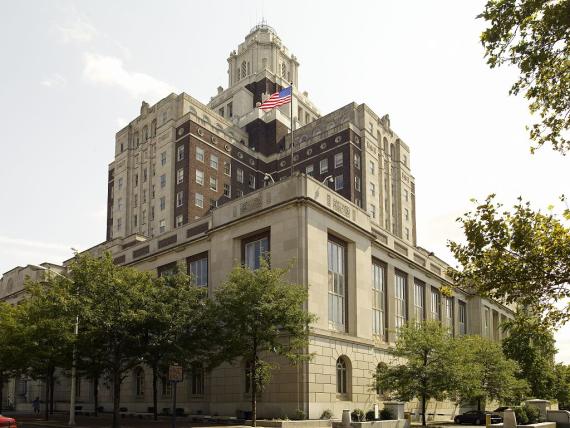Location: 200 Chestnut St, Philadelphia, PA 19106
History
The U.S. Customs Service was established by the first U.S. Congress in 1789, making it the oldest federal agency in the country. The functions of the Customs Service are to assess and collect duties and taxes on imported goods, to control carriers of imports and exports, and to combat smuggling and revenue fraud.
The U.S. Custom House in Philadelphia is a product of the great federal building projects of the Depression era. Begun in December 1932, it opened on November 10, 1934, at a final cost of more than $3,500,000. Distinguished by richness of materials, by the quality of its design, and by a decorative program by a major local artist, the U.S. Custom House is a fitting architectural monument to Philadelphia’s status as one of the nation’s largest ports.
The growth of Philadelphia as a prosperous center of industry at the turn of the twentieth century resulted in a greatly increased number of ships entering and leaving the port. As the U.S. Customs Service expanded to fulfill its duties, it outgrew its home since 1845 in the renowned Second Bank of the United States building, which was designed by William Strickland and completed in 1824.
The new U.S. Custom House documents the social and economic history of the early 1930s, vividly illustrating the federal government’s role in combating unemployment through large-scale building projects that employed local craftspeople, suppliers, and manufacturers while providing workers with a fair wage. In an effort to stimulate the economy following the stock market crash of 1929, Congress passed a bill appropriating funds for the U.S. Custom House in Philadelphia. The building’s construction helped spur the local economy by directly employing more than 4,000 workers for two years. Construction of the U.S. Custom House was the initial component of an early urban redevelopment plan that ultimately spread to include the creation of Independence National Historical Park and the revitalization of Society Hill.
Architecture
The final major work by Ritter & Shay, one of the most prominent architectural firms in Philadelphia, the new building respected its historic eighteenth-century neighborhood through the use of classical details on the broad, low base. However, it also reflected its own time with a bold, setback Art Deco tower with sheer surfaces and a tapered silhouette.
The U.S. Custom House occupies an entire city block in the heart of Philadelphia’s Historic District between Second, Chestnut, American, and Sansom Streets. It rises 17 stories from its base to its lantern. The 264-foot-square, three-story base is clad in limestone with decorative aluminum details and steel casement windows. The classically inspired base is highly responsive to the surrounding Georgian and Federal architecture. Semicircular metal bas-relief panels depicting American industry, commerce, and trade are set beneath the arched door openings of the main entrance.
Set back from the base’s perimeter, the tower rises in a cruciform plan, and is built of red brick with limestone trim and double-hung wood windows. The building culminates nearly 300 feet above the ground in an octagonal lantern (based on the ancient Lantern at the Greek Island of Rhodes) of white high-relief terra cotta with decorative side grilles and handsome limestone eagles. A 30-space garage was part of the original basement design.
The interior was the result of an extraordinary collaboration among Brandywine School artist George Harding, architect Howell Lewis Shay, and Philadelphia Museum of Art director Fiske Kimball (who recommended Harding). Harding’s significant mural program consists of a series of 31 separate panels in the vestibule, elevator lobby, and rotunda area. The selection of ornamental motifs, based entirely on nautical vignettes and images of commerce, underscore the building’s function. Ships, planes, conch shells, seahorses, and reclining Neptunes in George Harding’s murals are all representative of the building’s function next to one of the world’s largest freshwater ports.
The first floor follows a strong axial plan that focuses on a three-story rotunda with an elaborate plasterwork ceiling and adjacent light wells. A coffered plaster dome, supported by eight fluted serpentine marble columns, caps the striking three-story rotunda. Each coffer essentially consists of a large gold shell, and the frieze has eight panels showing the winds as depicted in Greek mythology. On either side of the main north-south corridor are spectacular circular stairs that rise under small secondary domes and provide access to offices on the second and third stories.
Although it appears to be in the center of the building, the rotunda is located in the front portion of the U.S. Custom House and cleverly disguises the loading docks, which comprise nearly half of the first floor.
The U.S. General Services Administration completed an extensive restoration of the U.S. Custom House in the early 1990s. The three-year project included conservation of original surface finishes, upgrading mechanical and lighting systems, and ensuring access for the disabled. The building is once again fully occupied, and annual energy costs have been reduced 60 percent.
Significant Events
- 1789: July 4, Philadelphia’s U.S. Customs Service established at Second and Walnut Streets.
- 1845: The U.S. Customs Service moves into the Second Bank of the United States.
- 1932: The Economy Act reduces the building’s budget, necessitating the substitution of limestone for the originally proposed marble trim.
- 1934: The U.S. Customs Service moves into current building at Second and Chestnut Streets.
- 1991-1993: The U.S. General Services Administration undertakes a major restoration and renovation of the structure.
- 2011: The U.S. Custom House is listed on the National Register of Historic Places
Facts
- Architect: Ritter and Shay
- Architectural Style: Art Deco
- Construction Dates: 1932-1934
- GSA Building Number: PA0144ZZ
- Landmark Status: Listed in the National Register of Historic Places
- Primary Materials: Limestone and brick with steel windows and aluminum ornamentation
- Prominent Feature: Rotunda, lobby, and Ceremonial Courtroom
Poster Download
Download the poster [PDF - 364 KB]

 U.S. General Services Administration
U.S. General Services Administration

